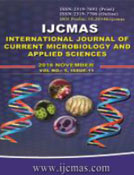


 National Academy of Agricultural Sciences (NAAS)
National Academy of Agricultural Sciences (NAAS)

|
PRINT ISSN : 2319-7692
Online ISSN : 2319-7706 Issues : 12 per year Publisher : Excellent Publishers Email : editorijcmas@gmail.com / submit@ijcmas.com Editor-in-chief: Dr.M.Prakash Index Copernicus ICV 2018: 95.39 NAAS RATING 2020: 5.38 |
Green tea and Black tea extracts are known to exhibit significant antibacterial activity against many pathogenic microbes. With the emerging threat of growing antibiotic resistance amongst bacterial strains posing serious challenge to clinicians left with few options there has been an increasingly growing interests to explore new antimicrobial compounds from herbal extracts, which could be incorporated in the treatment of such infections. So, this study was undertaken to evaluate and compare the antibacterial activity of different extracts of Green tea and Black tea against standard bacterial strains. This Cross-sectional Analytical study was conducted in the Department of Microbiology of a Tertiary care Teaching hospital of Central India over a period of three months. Antimicrobial activity of Aqueous, Ethanolic, Methanolic and Acetone extracts of Green tea and Black tea was determined by Agar well diffusion method. Green tea extracts exhibited higher antimicrobial activity than Black tea extracts. Amongst Green tea extracts aqueous extract was found to be most effective while amongst Black tea extracts methanolic extract was most effective. All tea extracts have shown significant antibacterial activity against S.aureus ATCC 25922 with Aqueous extract of Green tea exhibiting highest activity. All Green tea extracts exhibited significant activity against E.coli ATCC 25923 higher than Black tea extracts. As compared to Green tea extracts, Black tea extracts showed much lower activity against P.aeruginosa ATCC 27853. S.aureus was found to be most susceptible to tea extracts followed by E.coli and P.aeruginosa. Green tea and Black tea extracts have shown significant antibacterial activity with former being more effective than later. In future there is immense potential of clinical application of polyphenolic contents of tea extracts as adjuvant therapeutic agents to tackle the menace of growing antibiotic resistance.
 |
 |
 |
 |
 |